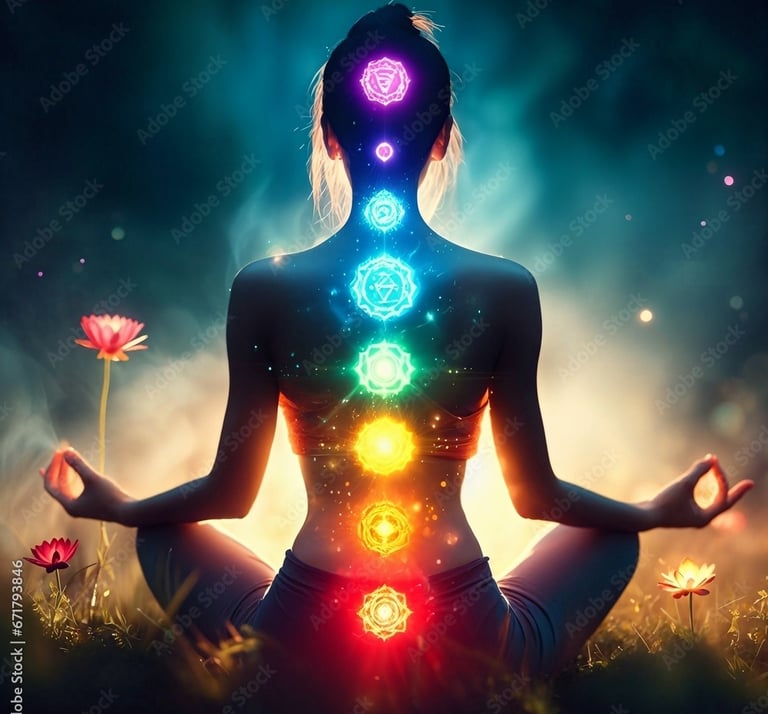Kundalini Awakening: Methods, Challenges, and the Journey to Stabilization
When the Kundalini awakens, your soul dances in the light of truth
4/1/20253 min read


Kundalini awakening is an intense spiritual transformation that leads to expanded awareness, profound shifts in consciousness, and ultimately, self-realization. This sacred energy, often depicted as a coiled serpent at the base of the spine, can be activated through various methods. However, the journey is not without its trials, and understanding how to navigate the awakening process is crucial for spiritual stability and integration.
Methods of Kundalini Awakening
Different traditions and spiritual schools offer various approaches to awaken the Kundalini. Each path has its own discipline, risks, and outcomes.
1. Mantra Chanting (Japa Yoga)
Chanting sacred sounds or bija mantras like “Om Namah Shivaya” or “Soham” can stimulate the vibrational energy required to awaken Kundalini. Repetitive chanting aligns the practitioner’s mind with higher frequencies and gradually raises consciousness.
2. Pranayama (Breathwork Techniques)
Breath control exercises such as Nadi Shodhana (alternate nostril breathing), Bhastrika (bellows breath), and Kapalabhati (skull-shining breath) help to balance pranic energies, removing blockages and igniting the dormant Kundalini.
3. Kriya Yoga
A structured set of inner energy techniques, Kriya Yoga involves specific breathwork and meditative exercises designed to accelerate spiritual evolution. Paramahansa Yogananda popularized this method in the West.
4. Tantra and Shaktipat (Direct Energy Transmission)
Tantric techniques involve the union of masculine and feminine energies through meditation and sometimes physical practices. Shaktipat, the direct transfer of spiritual energy from a Guru to a disciple, can instantaneously awaken Kundalini.
5. Meditation and Silence (Dhyana & Mauna)
Deep contemplation, surrender, and extended periods of silence allow the mind to become still, leading to spontaneous Kundalini awakening. This method is often associated with Advaita Vedanta and self-inquiry practices like those of Ramana Maharshi.
6. Devotion and Surrender (Bhakti Yoga)
For many, including myself, the path of love and devotion (Bhakti) is the most natural. By surrendering to a higher power—whether in the form of a deity, guru, or universal consciousness—one can experience a heart-centered awakening that eventually leads to full Kundalini activation.
7. Physical Disciplines (Hatha Yoga & Martial Arts)
Asanas (postures) in Hatha Yoga and certain martial arts (like Tai Chi) help purify the body and nervous system, making it a suitable vessel for Kundalini energy.
How to Deal with Different Chakra Awakenings
As Kundalini ascends, it activates different chakras, each presenting unique challenges and experiences.
1. Muladhara (Root Chakra)
Symptoms: Fear, survival instincts, financial worries. Solution: Grounding practices like walking barefoot on earth, eating root vegetables, and practicing Moolabandha (root lock).
2. Svadhisthana (Sacral Chakra)
Symptoms: Emotional turbulence, heightened sexual energy. Solution: Creative expression (art, music, dance), mindful intimacy, and working with water elements.
3. Manipura (Solar Plexus Chakra)
Symptoms: Power struggles, ego conflicts, digestive issues. Solution: Self-discipline, ego-surrender, and Agni (fire) meditation.
4. Anahata (Heart Chakra)
Symptoms: Overwhelming love, heartbreak, compassion overload. Solution: Bhakti Yoga, deep breathing, practicing self-love and forgiveness.
5. Vishuddha (Throat Chakra)
Symptoms: Communication issues, excessive talking or withdrawal. Solution: Mantra chanting, journaling, speaking one’s truth with balance.
6. Ajna (Third Eye Chakra)
Symptoms: Headaches, visions, psychic abilities increasing. Solution: Meditation, darkness retreats, balancing intuitive insights with rationality.
7. Sahasrara (Crown Chakra)
Symptoms: Ego dissolution, feeling disconnected from reality, bliss states. Solution: Grounding, surrender, balancing spirituality with everyday responsibilities.
The Setbacks of Ego
One of the most challenging aspects of Kundalini awakening is the confrontation with the ego. As consciousness expands, egoic structures break down, leading to identity crises, arrogance, or spiritual bypassing.
1. Ego Inflation: Some may feel superior due to their awakening, leading to guru syndrome.
2. Ego Resistance: Fear of losing control may block the full awakening process.
3. Spiritual Materialism: Accumulating spiritual knowledge without real transformation.
The best approach is humility, continued self-inquiry, and surrendering the need for control. Kundalini is not a personal achievement but a divine grace.
The Final Realization and Stabilization
Kundalini awakening is not the end but a beginning. Once the process stabilizes, the practitioner must integrate the wisdom into daily life. The final realization often comes when one sees that Kundalini (Shakti) and Shiva (Consciousness) are one and the same.
Stabilization involves:
Living a balanced life – harmonizing spiritual practice with worldly duties.
Diet and lifestyle – consuming sattvic (pure) food, avoiding excess stimulation.
Service and compassion – engaging in selfless acts to stay grounded.
Continued Sadhana – regular meditation, mantra, and inner work to deepen realization.
My Experience: The Path of Love and Devotion
My journey to Kundalini awakening was through Bhakti—the path of love and devotion. Unlike many who seek Kundalini activation as the primary goal, for me, surrender to the divine (Shiva) was paramount. The heart center dominated my experience, leading to profound states of devotion, love, and ultimately, self-realization. Only after this surrender did Kundalini fully awaken, reinforcing the truth that Shakti (energy) naturally follows Shiva (consciousness).
This realization led to an effortless unfolding of the Kundalini process, without the turmoil that many face. When surrender is primary, Kundalini awakening becomes a byproduct of divine grace rather than a forced endeavor.
Final Thoughts:
Kundalini awakening is a sacred journey that must be approached with respect, patience, and surrender. While various methods exist, the essence remains the same—self-purification and divine alignment. The greatest blessing is not in awakening Kundalini but in realizing that we were never separate from the divine to begin with.
The key to a smooth awakening is not chasing experiences but surrendering to the eternal presence within.
Awakening
Join our community for spiritual growth and insights.
Transform
Connect
+917206059921
© 2025. All rights reserved.